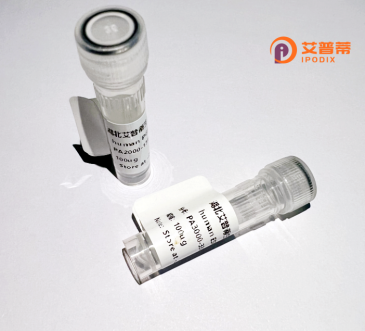
| 纯度 | >90%SDS-PAGE. |
| 种属 | Human |
| 靶点 | USP22 |
| Uniprot No | Q9UPT9 |
| 内毒素 | < 0.01EU/μg |
| 表达宿主 | E.coli |
| 表达区间 | 1-525 aa |
| 活性数据 | MVSRPEPEGE AMDAELAVAP PGCSHLGSFK VDNWKQNLRA IYQCFVWSGT AEARKRKAKS CICHVCGVHL NRLHSCLYCV FFGCFTKKHI HEHAKAKRHN LAIDLMYGGI YCFLCQDYIY DKDMEIIAKE EQRKAWKMQG VGEKFSTWEP TKRELELLKH NPKRRKITSN CTIGLRGLIN LGNTCFMNCI VQALTHTPLL RDFFLSDRHR CEMQSPSSCL VCEMSSLFQE FYSGHRSPHI PYKLLHLVWT HARHLAGYEQ QDAHEFLIAA LDVLHRHCKG DDNGKKANNP NHCNCIIDQI FTGGLQSDVT CQVCHGVSTT IDPFWDISLD LPGSSTPFWP LSPGSEGNVV NGESHVSGTT TLTDCLRRFT RPEHLGSSAK IKCSGCHSYQ ESTKQLTMKK LPIVACFHLK RFEHSAKLRR KITTYVSFPL ELDMTPFMAS SKESRMNGQY QQPTDSLNND NKYSLFAVVN HQGTLESGHY TSFIRQHKDQ WFKCDDAIIT KASIKDVLDS EGYLLFYHKQ FLEYE |
| 分子量 | 59.9 kDa |
| 蛋白标签 | His tag N-Terminus |
| 缓冲液 | PBS, pH7.4, containing 0.01% SKL, 1mM DTT, 5% Trehalose and Proclin300. |
| 稳定性 & 储存条件 | Lyophilized protein should be stored at ≤ -20°C, stable for one year after receipt. Reconstituted protein solution can be stored at 2-8°C for 2-7 days. Aliquots of reconstituted samples are stable at ≤ -20°C for 3 months. |
| 复溶 | Always centrifuge tubes before opening.Do not mix by vortex or pipetting. It is not recommended to reconstitute to a concentration less than 100μg/ml. Dissolve the lyophilized protein in distilled water. Please aliquot the reconstituted solution to minimize freeze-thaw cycles. |
以下是关于重组人USP22蛋白的3篇参考文献及其简要摘要:
---
1. **文献名称**:*USP22 regulates tumor progression by stabilizing LSD1 in colorectal cancer*
**作者**:Li Y. et al.
**摘要**:该研究通过在大肠杆菌中表达并纯化重组人USP22蛋白,揭示了其通过去泛素化酶活性稳定LSD1蛋白,从而促进结直肠癌细胞的增殖和转移。实验表明USP22的高表达与患者预后不良相关。
---
2. **文献名称**:*Structural and functional analysis of the USP22 deubiquitinating enzyme*
**作者**:Zhang X. et al.
**摘要**:本文解析了重组人USP22蛋白的晶体结构,并阐明了其底物识别及催化机制。功能实验表明,USP22通过去泛素化组蛋白H2B调控靶基因转录,进而影响细胞周期进程。
---
3. **文献名称**:*USP22 promotes tumor angiogenesis via deubiquitination of HIF-1α in glioma*
**作者**:Wang L. et al.
**摘要**:研究者利用哺乳动物细胞系统表达重组USP22蛋白,发现其通过去除HIF-1α的泛素化修饰增强其稳定性,进而促进胶质瘤血管生成。该过程依赖于USP22与HIF-1α的直接相互作用。
---
以上文献均聚焦于USP22的重组表达及其在癌症中的功能机制研究。如需扩展,可进一步查阅靶向USP22的药物开发或表观遗传调控相关研究。
USP22 (Ubiquitin-Specific Protease 22) is a deubiquitinating enzyme belonging to the USP subfamily, which plays a critical role in regulating protein stability, localization, and activity by removing ubiquitin molecules from target proteins. It is a key component of the mammalian SAGA (Spt-Ada-Gcn5-acetyltransferase) transcriptional coactivation complex and the Polycomb Repressive Complex 1 (PRC1), linking it to chromatin remodeling, histone modification, and epigenetic regulation. USP22 is notably involved in the deubiquitination of histone H2A and H2B, modulating transcriptional activation or repression of genes associated with cell cycle progression, differentiation, and stress responses.
Studies highlight USP22’s dual roles in cancer biology. While it supports embryonic development and stem cell pluripotency, its overexpression in multiple cancers (e.g., colorectal, breast, and lung cancers) correlates with tumor progression, therapy resistance, and poor prognosis. USP22 promotes oncogenesis by stabilizing cancer-related proteins (e.g., c-Myc, TRF1) and enhancing anti-apoptotic signaling pathways.
Recombinant human USP22 protein, produced via bacterial or eukaryotic expression systems, serves as a vital tool for in vitro studies. Researchers use it to explore enzymatic kinetics, substrate interactions, and inhibitor screening. Structural analysis of recombinant USP22 further aids in elucidating its catalytic mechanism and developing targeted therapies. Its role in epigenetic and oncogenic pathways continues to make USP22 a focal point in both basic research and drug discovery.
×